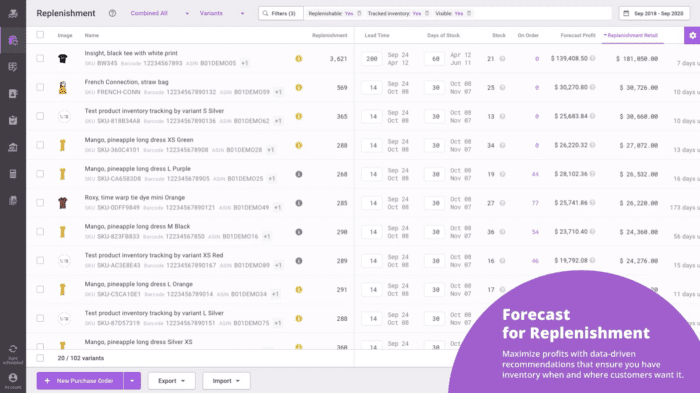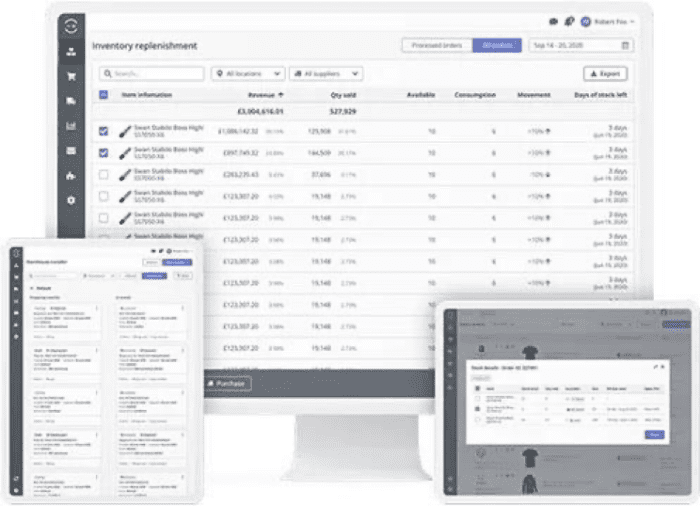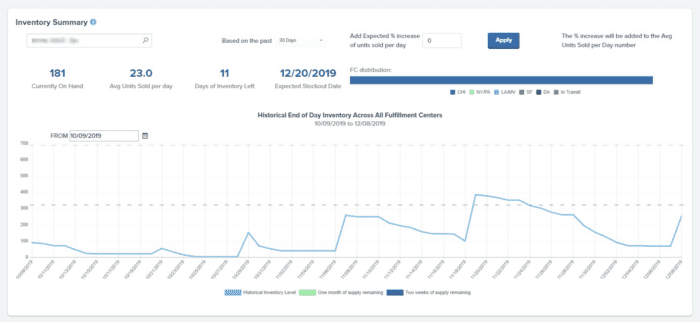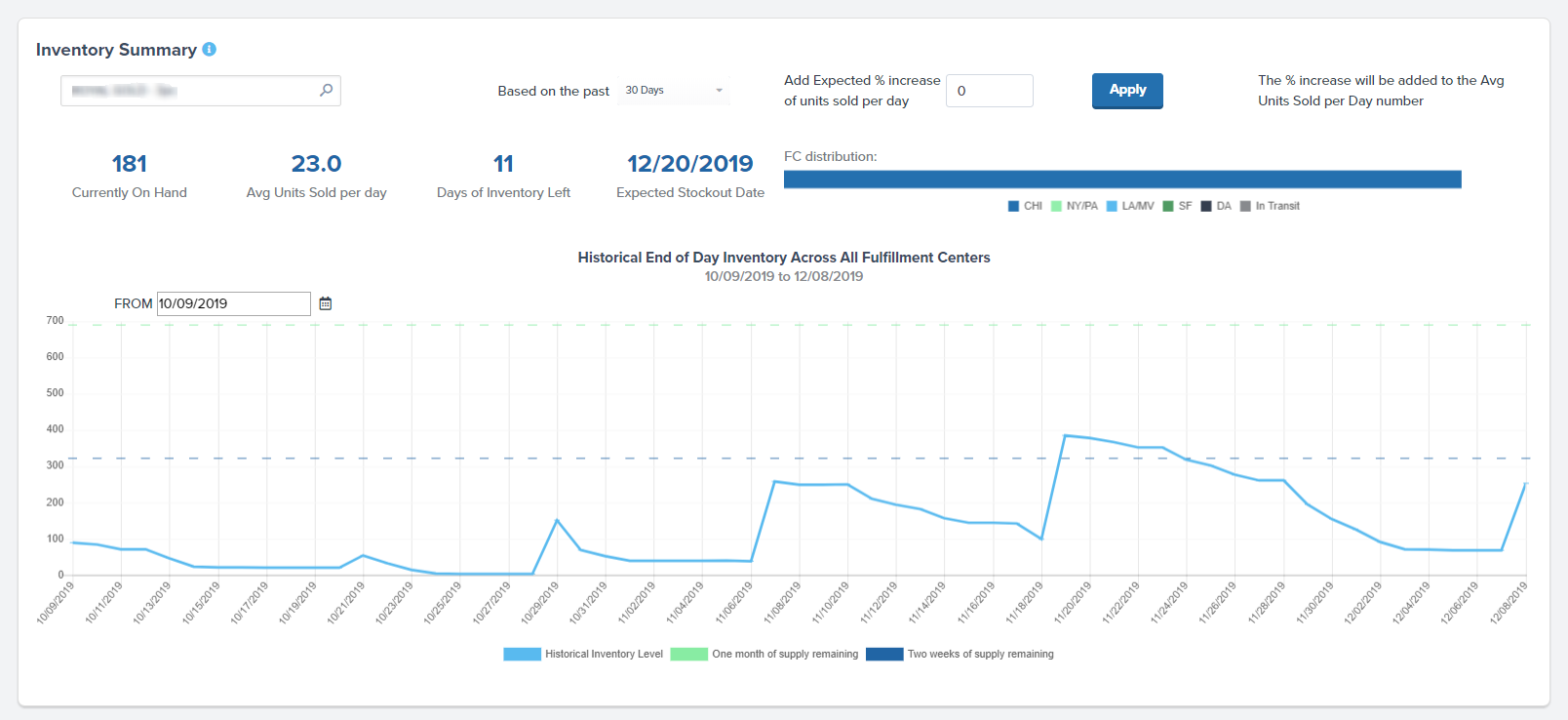Inventory Management Software Guide
Want to maximize your sales while reducing the complexities of inventory management?
Then you’ll need the right inventory solutions software on your side.
Here’s why having the right system is essential, plus how to choose the best inventory management software (or IMS) for your ecommerce business.
So, what do you want to learn?
Request Fulfillment Pricing
Let’s talk. Our experts can help you boost your order volume by 30% year over year.
A fulfillment expert will get back to you shortly. Privacy Policy
Top 5 inventory management software solutions for 2024
The hunt for the right inventory management software for your business can be tedious. While free trials are available, you don’t want to get roped into paying for a tool you don’t like.
To help you assess which IMS is right for you, here’s a breakdown of some of the most popular solutions on the market today.
Table stakes
Before evaluating a potential IMS solution, merchants should understand the industry table stakes – in other words, the features and capabilities that every potential IMS solution should provide.
For inventory management software, industry table stakes include:
- Integrations – connects easily and seamlessly with popular ecommerce platforms and tools
- Multichannel support – syncs inventory data across various sales channels and warehouse locations to deliver omnichannel visibility
- Automations – leverages automations to streamline inventory functions
- Analytics – provides real-time data on key inventory metrics, and tracks data over time to inform demand forecasting
Below, we’ll cover how these IMS solutions meet the criteria listed above, and what sets each one apart.
1. Inventory Planner

As its name implies, Inventory Planner is an IMS that specializes in demand forecasting and inventory reporting. While it meets table stakes, Inventory Planner’s software goes deep into over 200 metrics across a brand’s locations to create specialized buying recommendations and inventory insights. This makes their solution a standout for any ecommerce brand looking for unparalleled inventory data.
| Best for: | Brands looking for an IMS with in-depth demand forecasting, purchasing, and reporting capabilities |
| Key Features: | – Meets table stakes – In-depth reporting on 200+ inventory metrics – Readily available demand forecasting data |
| Pricing: | Pricing upon request; plans start at $249.99/month |
| Pros: | – Fast onboarding – Integrates easily with major ecommerce platforms |
| Cons: | Customization may be limited |
Inventory Planner is a cloud-based multichannel inventory management apps designed for online stores. With Inventory Planner, you can optimize your cash flow and time with an inventory forecast based on sales trends, vendor lead time, and targeted stock levels.
Inventory Planner is a great extension to ShipBob’s built-in inventory management tools. ShipBob offers a direct integration with Inventory Planner, making it much easier to track inventory in real time across a distribution network.
“Another ShipBob integration I love is Inventory Planner. It saves me hours every week in Excel spreadsheets, and I can raise a PO in minutes when it used to take me hours.
For every order I placed for years, I was ordering too much or not enough. Between inventory forecasting tools and the ability to auto-create WROs, we don’t have stockouts much anymore. I sleep better at night.”
Wes Brown, Head of Operations at Black Claw LLC
2. Linnworks

While Linnworks’ IMS meets table stakes, it shines when it comes to omnichannel inventory visibility. Linnworks leverages automation to synchronize inventory activity and data across multiple locations, and integrates with over 100 ecommerce platforms and tools so that brands can seamlessly manage inventory across all their sales channels.
As a result, it’s a great solution for brands juggling multiple sales channels that want a simpler way to manage their inventory.
| Best for: | Brands selling on multiple channels looking for a way to manage inventory across them all |
| Key Features: | – Meets table stakes – Product listings automatically update when SKUs hit their thresholds to help prevent stockouts – Bulk product uploads and price syncing across channels |
| Pricing: | Pricing upon request |
| Pros: | Highly integratable |
| Cons: | Somewhat complex interface |
3. Cin7
Cin7 is a go-to for many brands looking for an IMS that delivers on all the important capabilities. Its Core solution is equipped with table stakes inventory management features (including automatic inventory syncing across channels and warehouses, inventory reporting, and integrations with major ecommerce tools), while its Omni solution goes above and beyond for enterprise brands with built-in EDI access and unlimited users.
| Best for: | Brands that want a well-rounded IMS that works for small, mid-size, and large brands |
| Key Features: | – Meets table stakes – Built-in point-of-sale (POS) system |
| Pricing: | Plans between $325/mo – $999/mo |
| Pros: | – Highly integratable (700+ connections supported) – Good customer support |
| Cons: | API connections and unlimited integrations not included in price for standard, retailing, and manufacturing plans |
4. BrightPearl
For ecommerce brands that sell through lots of retail channels, Brightpearl offers an IMS that streamlines inventory and order management across them all, and consolidate inventory data in one place.
Its end-to-end functionality includes POS and CRM systems so that merchants can sync and track inventory data across channels at every stage, and its extensive process automation engine enables merchants to automate much of the daily grind of inventory management.
| Best for: | Brands looking to streamline inventory management across retail channels |
| Key Features: | – Meets table stakes – Rules-based automation engine – Built-in CRM, POS, and accounting systems |
| Pricing: | Pricing upon request |
| Pros: | – Good customer support – Highly automatable |
| Cons: | Pricing could be more transparent |
5. ShipBob

At the risk of being self-serving, we had to include ShipBob on this list of the top inventory software solutions. We have proprietary inventory management software that delivers top-notch, table stakes inventory management capabilities, including:
- A real-time analytics dashboard that merchants can use to monitor inventory KPIs
- Synced inventory tracking at the SKU level across warehouses and sales platforms for omnichannel visibility
- Tools to calculate a brand’s ideal inventory distribution across ShipBob’s network
- Recorded data on past inventory and order trends to improve demand forecasting
- Dozens of integrations with top ecommerce tools
- Automatic reorder notifications when a SKU hits its threshold to help time replenishment
But what sets ShipBob apart from other IMS solutions is that, as a tech-enabled 3PL, ShipBob offers merchants a way to manage inventory, fulfillment, and shipping through one partner.
ShipBob will handle the entire fulfillment and shipping process for you, storing your inventory in one of our 50 fulfillment centers worldwide and picking and packing orders as soon as they come in. From a single dashboard, ShipBob customers can check their inventory, monitor fulfillment operations, and track orders as they’re shipped – and by outsourcing logistics to experts, merchants can optimize their logistics end-to-end while saving money and time.
“We have a Shopify store but do not use Shopify to track inventory. In terms of tracking inventory, we use ShipBob for everything — to be able to track each bottle of perfume, what we have left, and what we’ve shipped, while getting a lotmore information on each order.”
Ines Guien, Vice President of Operations at Dossier
| Best for: | Ecommerce brands looking for an all-in-one platform that delivers an outstanding IMS as well as an outsourced fulfillment and shipping solution |
| Key Features: | – Meets table stakes – IMS included in fulfillment solution at no extra cost – Ideal inventory distribution tool to calculate the most strategic stock allocation across 50+ fulfillment centers – IMS accessible for outsourced, in-house, and hybrid solutions |
| Pricing: | Pricing upon request |
| Pros: | – Fast onboarding – Intuitive design – Global and omnichannel visibility (including B2B retail dropshipping and distribution) |
| Cons: | Not a standalone IMS |
ShipBob comes highly reviewed for providing all of the features you need: easy to use, efficient order management, accurate tracking and reporting, and fantastic customer support.
ShipBob is the #1 because we handle ALL of your inventory management and retail fulfillment needs in one place, although we also work with other inventory management partners that can handle additional needs of our customers.
What is inventory management software?
Inventory management software is software that’s specifically designed to help you track your inventory — whether in-house or in a 3PL’s warehouse — in order to help you always have the right quantity of products at the right time.
When used effectively, this software can help avoid losing money from unsold products, report on inventory levels and trends in real-time, and offer suggestions for inventory control and distribution.
6 reasons to use an inventory management system
Inventory management software helps automate and streamline the inventory management process by tracking inventory levels,, sales orders, and shipments. It can also help automate inventory tracking, saving time and preventing potential human errors for your business.
Not quite convinced that using inventory management software is the best move for your ecommerce business? Here are some more benefits to consider:
1. Provide visibility across departments
Inventory management software will help you keep track of inventory in the various departments of your business, typically all within a single dashboard. You’ll be able to see your inventory numbers at a glance and know if you need to scale your product numbers up or down. Implementing this across departments will also help your employees be more efficient when it comes to ordering products and managing resources.
2. Keep your store in stock
Stockouts can significantly hurt your online sales because your customers won’t be able to order the products they want. To avoid out of stock issues, your chosen inventory management software will help you calculate the ideal amount of inventory you need at any given time.
3. Get repeat customers
You want your customers to come back and order your products time and time again. Using an inventory management system helps you keep your customers happy by always having the products you need in stock. This increases the customer experience and the likelihood that your happy customers will come back and order more.
4. Know who needs inventory and when
Experiencing massive business growth is great, but scaling up can bring on a whole slew of issues — one of them being the need to manage multiple channels at once. If you have multiple stores, warehouses, or product lines, you’ll need an inventory management solution that allows you to see which areas need inventory and when — all within a single tool.
5. Increase inventory turnover ratio
Having a high inventory turnover ratio ensures that your products aren’t becoming obsolete, spoiling before they ship out, or holding up too much capital. The right software will help you calculate how much inventory you sell for a given period and provide insight into how you can make better use of your existing resources.
6. Save money
Having too much inventory can tie up capital (or end up being a waste of money), while not having enough inventory can result in a loss in sales. A key feature of inventory tracking software is it helps you find the sweet spot so that you always have just enough inventory on-hand or in your warehouse. This efficiency will help you save (and make) loads of money through your ecommerce store.
What to look for in inventory management software
Utilizing inventory management software in your ecommerce platform will make managing inventory for your online store a breeze. But before doing a Google search for “inventory management software” and purchasing the first tool that comes up, we recommend you make sure your chosen tool includes all of the features below:
Real-time inventory
If you are monitoring your inventory counts manually, you’ll probably come to realize a problem after it’s too late. Sales can happen quickly, so you’ll need a tool that will track inventory in real-time. Your chosen software should be able to analyze the data to optimize fulfillment, eliminate stockouts, and prevent excess inventory. Just in time (JIT) inventory management may not always be possible, so real time is your next best solution.
Inventory trends and future forecasting
Smart inventory management software will help with inventory optimization by analyzing past selling trends and will adjust your inventory accordingly. For example, if you routinely face out of stock issues around the holidays, your software will ensure that you have more inventory available during this time period. It should also be able to make future projections about how much product you need and when.
Ability to set reorder points
You don’t want to wait until you run out of inventory before ordering more, because it can take days or weeks to acquire more products. Your chosen software should allow you to set reorder points to give you a bit of a “buffer zone,” ensuring that you automatically reorder products before you run out.
Easy to use
What’s the point in opting for a new tool that makes your life more difficult? To reduce stress when it comes to managing your inventory, choose software that has been reviewed as customer-friendly and easy to use. You can typically find this information by searching for information online or by signing up for a trial.
“So many 3PLs have either bad or no front-facing software, making it impossible to keep track of what’s leaving or entering the warehouse.
On the supply chain side, I just throw in what we placed at the factory into a WRO in the ShipBob dashboard, and I can see how many units we have on-hand, what’s incoming, what’s at docks, and so on. I can see all of those numbers in a few seconds, and it makes life so much easier.”
Harley Abrams, Operations Manager of SuperSpeed Golf, LLC
Why use ShipBob for inventory management?
What makes ShipBob the best inventory management software? The fact that we’re a 3PL that provides inventory management software, meaning the technology you use also powers our network of fulfillment centers.
As you scale your ecommerce business, you’ll realize that in-house fulfillment can quickly become a logistical nightmare. By outsourcing fulfillment to a 3PL company, you can fully expand your fulfillment strategy while reducing the costs of excess inventory.
ShipBob is able to address all of your inventory management and fulfillment needs. Here’s why using a 3PL for inventory tracking outshines all other solutions:
Full order fulfillment
Have you ever ordered a product online, just to have a less-than-stellar delivery experience? If your order was delayed, lost, or damaged, this was likely due to order fulfillment issues.
Going with a 3PL company will help you prevent these problems in your business by managing fulfillment from start to finish. For instance, ShipBob handles all the receiving, processing, packing, and shipping of online orders to your customers — a process that’s completely hands-off for you!
Warehousing inventory
Many ecommerce sellers need warehousing space that is cost-effective for them. Working with a 3PL makes it easy to order more inventory when you need it and also expand into additional fulfillment centers as you grow.
“Off the bat, I liked that I would be able to control multiple warehouses through one page with ShipBob. With my old 3PL, I could never just open a page and get the info I wanted. I had to click several times, then export it, and try to make sense of it. ShipBob lets you manage your inventory while providing important data in a very digestible way.”
Wes Brown, Head of Operations at Black Claw LLC
ShipBob is designed to help you turn over your inventory quickly by offering inventory storage space in pallets, shelves, and bins for your business. Going the 3PL route saves you time and money, and prevents unnecessary delivery delays.
Inventory tracking
Knowledge is power. The more accurate data you have, the easier it will be to make informed decisions about your business. A data-driven 3PL company should be able to help you with demand forecasting, reorder points, and more to help your business run more efficiently. From the ShipBob dashboard, you can view SKU performance over time and calculate inventory days on hand all in real time (see image below).

All data is one place
The best inventory management solution will carry business to business, but a 3PL can be an all-in-one tool that’s more cost-effective than utilizing multiple tools at once, and is more efficient than trying to sync up disparate systems and manage all the steps of the fulfillment process on your own. It’ll have your inventory system running like clockwork.
Automate fulfillment for faster, easier shipping
Packaging up your products and manually shipping out orders is exhausting. A 3PL takes all of this off your hands by managing the packing, packing, shipping, and tracking of your orders for you. That means your customers will get their orders faster and you’ll be able to relax knowing that your inventory management is in good hands.
Conclusion
Avoid the common headaches that come with managing your ecommerce inventory. With the right inventory management software, you’ll save money on fulfillment, prevent out of stock issues, avoid ordering excess stock, and effectively plan ahead for future sales.
All of these benefits relieve your stress as a business owner and keep your customers happy. Experience this for yourself with ShipBob. Learn more about how ShipBob helps with inventory management and get a pricing quote.
Inventory management software FAQs
Have more questions about why you need inventory management software, how it works, and where to find the best solution for you? If so, check out some frequently asked questions section below:
When should I set my reorder point?
Avoid running out of inventory by setting reorder points ahead of time. You can follow the formula (Lead Time Demand + Safety Stock = Reorder Point) to calculate the inventory amount you will need to set your reorder points. Read this article to get more information.
How much inventory should I order?
Determining the right amount of inventory at the SKU level will vary depending on your available warehouse space, past demand, manufacturer leads times, upcoming promotions, and other variables. Read this article on inventory forecasting to learn more.
What do I do during holiday seasons/high order times?
Black Friday, Christmas, and other holidays can amp up your purchase orders and sales. Holiday inventory preparation means calculating how much inventory you need ahead of time. ShipBob does the hard work for you by analyzing trends (and your past sales) to determine how much inventory you need on-hand during high order times. Maximize sales without wasting money on excess inventory.
See how different direct-to-consumer businesses, including those that are very seasonal in nature manage their inventory here
Can I use multiple ShipBob warehouses?
Yes! ShipBob is a 3PL company that owns and operates multiple fulfillment centers within the continental US. This functionality allows us to offer two-day shipping at ground prices across the country. This also means that we help reduce the distance packages have to travel, cutting down on transit time and shipping costs.